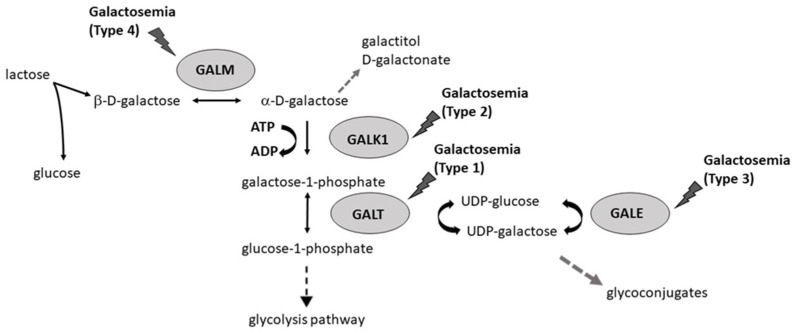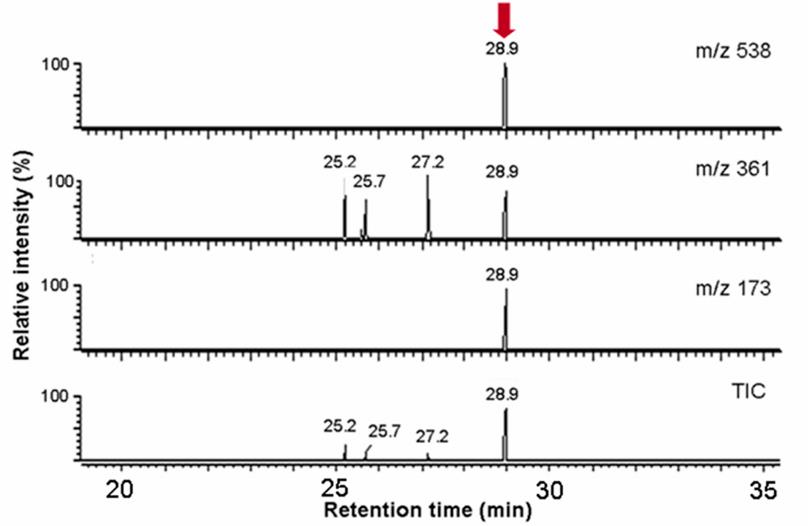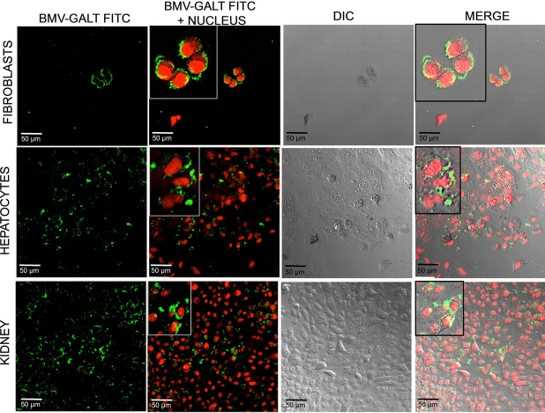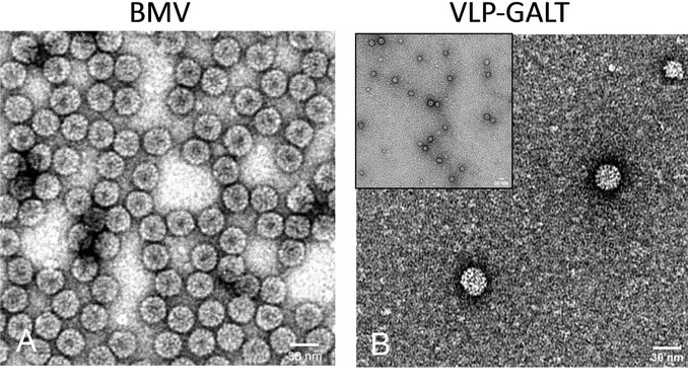GALT
-
Official Full Name
galactose-1-phosphate uridylyltransferase -
Overview
Galactose-1-phosphate uridyl transferase (GALT) catalyzes the second step of the Leloir pathway of galactose metabolism, namely the conversion of UDP-glucose + galactose-1-phosphate to glucose-1-phosphate + UDP-galactose. The absence of this enzyme results in classic galactosemia in humans and can be fatal in the newborn period if lactose is not removed from the diet. The pathophysiology of galactosemia has not been clearly defined. -
Synonyms
GALT;galactose-1-phosphate uridylyltransferase;gal-1-P uridylyltransferase;galactose-1-phosphate uridyl transferase;UDP-glucose--hexose-1-phosphate uridylyltransferase
Recombinant Proteins
- Bacillus subtilis
- Rat
- Human
- Zebrafish
- Yeast
- Mouse
- E.Coli/Yeast
- Mammalian Cells
- E.coli
- HEK293
- Yeast
- In Vitro Cell Free System
- His
- Non
- T7
- Avi
- Fc
- DDK
- Myc
- SUMO
- GST
Background

Fig1. Schematic representation of the Leloir pathway and associated reactions. (Mariangela Succoio, 2022)
What is GALT Protein?
GALT gene (galactose-1-phosphate uridylyltransferase) is a protein coding gene which situated on the short arm of chromosome 9 at locus 9p13. Galactose-1-phosphate uridyl transferase (GALT) catalyzes the second step of the Leloir pathway of galactose metabolism, namely the conversion of UDP-glucose + galactose-1-phosphate to glucose-1-phosphate + UDP-galactose. The absence of this enzyme results in classic galactosemia in humans and can be fatal in the newborn period if lactose is not removed from the diet. The GALT protein is consisted of 379 amino acids and GALT molecular weight is approximately 43.4 kDa.
What is the Function of GALT Protein?
GALT catalyzes the conversion of UDP-glucose with galactose-1-phosphate to glucose-1-phosphate and UDP-galactose. Inadequate GALT enzyme activity leads to the accumulation of galactose-1-phosphate in the body, resulting in galactosemia, a potentially life-threatening condition. In addition, human gut-associated lymphoid tissue (GALT) is a key antigen sampling and adaptive immune induction site within the intestinal wall, including Peyer's spot in the small intestine, the worm-like appendix, and numerous isolated lymphoid follicles (ILFs) along the intestinal tract. These GALTs have the potential to modulate the intestinal immune response in maintaining intestinal immune homeostasis and inflammatory bowel disease (IBD).
GALT Related Signaling Pathway
In mouse fibroblasts, GALT defects lead to downregulation of PI3K/Akt growth signaling pathway through different mechanisms, affecting cell growth and metabolism. GALT, as part of the intestinal associated lymphoid tissue (GALT), plays a key role in intestinal immunity, affecting the first line of intestinal mucosal immunity, including non-specific recognition and killing of pathogenic bacteria, the presentation of antigens to activate adaptive immune responses, and the maintenance of immune tolerance. The conserved antigen of GALT in Actinobacillus pleuropneumoniae improves cytokine secretion in macrophages and promotes the expression of pro-inflammatory cytokines through p38, ERK1/2 and JNK MAPKs signaling pathways.
GALT Related Diseases
Galt-related diseases are mainly galactose metabolism disorders caused by insufficient activity of this enzyme, such as galactosemia, which is a genetic metabolic disease, patients cannot metabolize galactose correctly, resulting in the accumulation of galactose and its metabolic intermediates in the body, which may cause damage to liver, kidney, brain and other organs, abnormal development of the nervous system, and high mortality in the neonatal period. In addition, mutations in the GALT gene may also be associated with other diseases, such as certain types of cancer, where abnormal expression of GALT may affect the metabolic characteristics and treatment response of tumor cells due to its role in cell proliferation and metabolism.
Bioapplications of GALT
Off-the-shelf applications of GALT (galactose-1-phosphate uridine transferase) are mainly in the field of clinical diagnosis, especially for the detection and monitoring of galactosemia. By measuring the activity of GALT in blood or other biological samples, doctors can diagnose abnormalities in galactose metabolism due to defects in this enzyme. In addition, the determination of GALT activity is also useful for assessing a patient's response to treatment with specific dietary restrictions, as well as monitoring the control of galactose levels in the patient.
Case Study
Case Study 1: Verena Janes, 2020
In search for cellular pathomechanisms induced by the stressor galactose, researchers looked for ways to induce metabolically a galactosemia-like phenotype by hGALT inhibition in HEK293 cells. In kinetic studies, we provide evidence for 2-fluorinated galactose-1-phosphate (F-Gal-1-P) to competitively inhibit recombinant hGALT with a KI of 0.9 mM. Contrasting with hepatic cells, no alterations of N-glycoprofiles in MIG (metabolic induction of galactosemia)-HEK293 cells were revealed for an inducible secretory netrin-1 probe by MALDI-MS. Differential fluorescence-activated cell sorting demonstrated reduced surface expression of N-glycosylated CD109, EGFR, DPP4, and rhMUC1. Most prominent, a negative regulation of oxidative stress was revealed presumably as a response to a NADPH pool depletion during reduction of Gal/F-Gal. Cellular perturbations induced by fluorinated galactoses in normal epithelial cells resemble proteomic changes revealed for galactosemic fibroblasts.

Fig1. Lineweaver–Burk (LB) plots of two independent triplicate kinetic assays based on coupled enzyme methodology.

Fig2. Total ion current (TIC) and mass selective chromatograms of trimethylsilytated oligosaccharides.
Case Study 2: Pedro Gama, 2021
Enzymatic nanoreactors were obtained by galactose-1-phosphate uridylyl-transferase (GALT) encapsulation into plant virus capsids by a molecular self-assembly strategy. The aim of this work was to produce virus-like nanoparticles containing GALT for an enzyme-replacement therapy for classic galactosemia. The encapsulation efficiency and the catalytic constants of bio-nanoreactors were determined by using different GALT and virus coat protein ratios. The substrate affinity of nanoreactors was slightly lower than that of the free enzyme; the activity rate was 16 % of the GALT free enzyme. The enzymatic nanoreactors without functionalization were internalized into different cell lines including fibroblast and kidney cells, but especially into hepatocytes. The enzymatic nanoreactors are an innovative enzyme preparation with potential use for the treatment of classic galactosemia.

Fig3. Internalization of VLP-GALT nanoreactors conjugated with FITC.

Fig4. TEM images of A) BMV virions and B) nanoreactors with GALT activity.
Quality Guarantee
High Purity
.jpg)
Fig1. SDS-PAGE (GALT-4714H)
.
.jpg)
Fig2. SDS-PAGE (GALT-2582H)
Involved Pathway
GALT involved in several pathways and played different roles in them. We selected most pathways GALT participated on our site, such as Galactose metabolism,Amino sugar and nucleotide sugar metabolism,Metabolic pathways, which may be useful for your reference. Also, other proteins which involved in the same pathway with GALT were listed below. Creative BioMart supplied nearly all the proteins listed, you can search them on our site.
| Pathway Name | Pathway Related Protein |
|---|---|
| Amino sugar and nucleotide sugar metabolism | HK1,CYB5R1,RENBP,GMDS,NANSA,GNPDA2,GFPT2,PMM2,CHIA.3,GNE |
| Prolactin signaling pathway | PIK3R3,HRAS,KRAS,SHC2,CCND2,AKT2,MAPK10,TNFRSF11A,SOCS4,ESR2 |
| Galactose metabolism | AKR1B1L,UGP2A,HK3,GALK1,aLA,AKR1B7,G6PCA.1,UGP2,GLA,G6PCA.2 |
| Metabolic pathways | FBP1,LTA4H,DHRS3,GALE,ALDH3A2A,PPT1,NAT2,ST3GAL2,UGDH,ATP6V1C1A |
Protein Function
GALT has several biochemical functions, for example, UDP-glucose:hexose-1-phosphate uridylyltransferase activity,protein binding,zinc ion binding. Some of the functions are cooperated with other proteins, some of the functions could acted by GALT itself. We selected most functions GALT had, and list some proteins which have the same functions with GALT. You can find most of the proteins on our site.
| Function | Related Protein |
|---|---|
| protein binding | MAP4K3,NUDT1,CC2D2A,ABCG8,EXOSC3,CTGF,C10orf46,PAIP1,C7orf31,PDLIM2 |
| zinc ion binding | CDADC1,RNF13,LHX1,ZCRB1,RAD18,RNF187,CSRP1B,GATA6,NEURL1B,TAB3 |
Interacting Protein
GALT has direct interactions with proteins and molecules. Those interactions were detected by several methods such as yeast two hybrid, co-IP, pull-down and so on. We selected proteins and molecules interacted with GALT here. Most of them are supplied by our site. Hope this information will be useful for your research of GALT.
TNK2;TRIP13
Resources
Related Services
Related Products
References
- Coelho, AI; Lourenco, S; et al. Functional correction by antisense therapy of a splicing mutation in the GALT gene. EUROPEAN JOURNAL OF HUMAN GENETICS 23:500-506(2015).
- Viggiano, E; Marabotti, A; et al. Clinical and molecular spectra in galactosemic patients from neonatal screening in northeastern Italy: Structural and functional characterization of new variations in the galactose-1-phosphate uridyltransferase (GALT) gene. GENE 559:112-118(2015).



